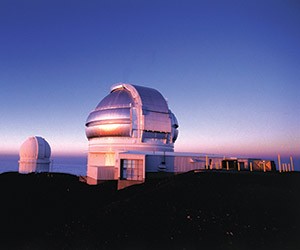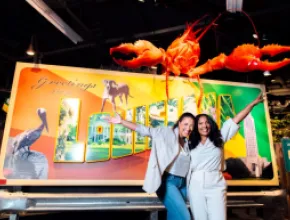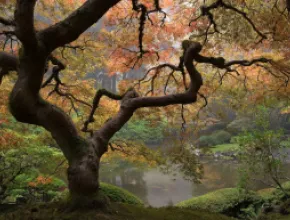Hawaii boasts some of the Earth’s most dazzling star-studded nightlife—and it has nothing to do with spotting celebrities. These stargazing activities are centered on Hawaii’s spectacular night skies—and take place in venues that range from mountain peaks to hotel rooftops and cruise boats.
“Stargazing is especially good in Hawaii because of our clear skies and the fact that many locations do not have bright lights that obscure the night skies,” says Kathy Clarke, president of Kathy Clarke Hawaii (www.kathyclarkehawaii.com), a DMC that arranges star-themed activities for groups. “The fact that we’re close to the equator means that you actually see more stars then you do on the mainland. You can see a broader range that takes in both hemispheres.”
Themed Events
Events that include stargazing can be arranged in locations all over Hawaii, including at hotels, some of which have their own in-house stargazing programs.
“There are a million variations on the stargazing theme that you can do for events,” Clarke says. “Typically, we will bring in three or four high-powered telescopes accompanied by astronomers. This can happen on all of the islands.”
Stargazing-themed events can also combine the mystical with the scientific, with the addition of astrologers, palm readers and the like, she adds.
“We can also bring in a Hawaiian navigator to describe how the ancient Polynesians navigated all over the Pacific by using the stars—there’s even evidence of their early landings in Oregon and California,” Clarke says. “The navigator will come in and ‘talk story’ about the Polynesians’ philosophy about the stars, which is very different than the Western mindset about navigation.”
Many themed events are held at resorts in their outdoor function spaces. Among them is the rooftop of the Hyatt Regency Maui (www.hyatt.com), where the hotel’s director of astronomy uses a computer to locate stars, planets, galaxies and nebulae. Participants first learn to interpret the sky with an unaided eye, then with high-powered binoculars and then through “Great White,” a 16-inch reflector telescope.
Another star-themed activity is the “Evening Under the Stars” program at the Makena Beach & Golf Resort (www.makenaresortmaui.com) on Maui. Participants experience high-tech stargazing through iPads equipped with Sky Safari applications. They also learn about ancient Hawaiian star navigation while enjoying hot cocoa and s’mores around a campfire.
Along with hotels, private luxury homes such as the Big Islands’ Sullivan House are available for evening rental and are also ideal for events with a stargazing theme, according to Clarke.
“These homes are usually on the water and away from city lights, so you can really enjoy the peace and serenity that comes with stargazing,” she says. PageBreak
Astronomy Center
Located in Hilo on the University of Hawaii campus, the Imiloa Astronomy Center of Hawaii (www.imiloahawaii.org) is a group-friendly venue known for its state-of-the-art planetarium, the first in the world to offer 3-D stereoscopic capabilities. With a 52-foot dome ceiling and 120 reclining seats, the planetarium features IMAX-style presentations on the Hawaiian skies designed to make viewers feel like they are flying through space. The planetarium also offers presentations by local astronomers.
The planetarium, which is available for conference sessions requiring high overhead visibility for presentations, is one of several possible event spaces at Imiloa. Along with buying out the entire facility, groups can hold seated meal events in the Sky Garden Restaurant or have a reception in the 12,000-square-foot Exhibit Hall while enjoying exhibits that weave together Hawaiian culture and astronomy.
Peak Experience
Venturing up the 13,796-foot summit of Mauna Kea on the Big Island may be the ultimate stargazing adventure, one that is offered by the outfitter Hawaii Forest & Trail (www.hawaii-forest.com). On the way up the mountain in four-wheel-drive vehicles, the Mauna Kea tour stops for a hot, picnic-style dinner at a historic ranch outpost before continuing up to the summit for spectacular sunset views. At the summit are 13 telescopes representing 11 countries. After sunset, the vehicles head down to the Onizuka Center for International Astronomy Visitor Information Station, set at 9,300 feet above sea level, for a look at the heavens through a high-powered telescope. The tours are accompanied by a naturalist guide, who shares knowledge of Hawaiian astronomy and lore.
Meteors and Mantas
Hawaii’s night skies can also be enjoyed on special evening cruises. Among them are cruises offered by Wild Side Hawaii (www.sailhawaii.com) that are scheduled around meteor showers, eclipses and other stellar occurrences. Departing from Waianae Harbor on Oahu, the stargazing cruises are on a 42-foot catamaran, which can also be chartered for group excursions.
While designed to observe unique sea creatures rather than stars, Manta Ray Night Cruises are another starlit option. The cruises, which are offered by companies such as Sea Paradise (www.seaparadise.com), sail out of Keahou Bay on the Big Island’s Kona Coast to a habitat where participants can snorkel or dive amid the gentle giant rays.







